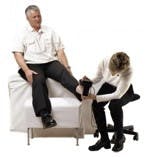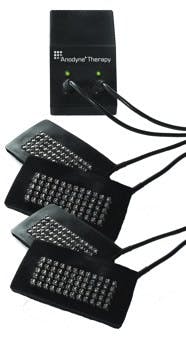Anodyne Therapy: A Photo-Energy Treatment Modality
Treatment
"Typical" Treatment Protocols
The Anodyne portion of typical treatment sessions are 30-45 minutes, three times per week for four weeks. This may vary based on the initial clinical assessment and the patient's degree of functional impairment. Treatment pads are lightly placed over the problem areas. In areas with swelling or poor venous or arterial flow, pads are also placed proximal to the treatment area. A thin clear plastic barrier film covers the pad surface or skin. Pads are checked every 10 minutes, especially when located over bony prominences or areas with compromised circulation or skin, lack of sensation, or wounds.


What to Expect During Treatment
Our therapists will conduct a clinical assessment of your condition. They will ask you about your goals for therapy. The therapists will then determine the best therapy program to complement your physical needs and treatment goals. They will design a care plan that will include physical or occupational therapy interventions to help you with strength, flexibility, range of motion, balance, endurance, etc. based on your personal goals, and will work with you to achieve those goals.
Patients usually feel a soothing warmth during Anodyne treatment. However, some experience a tingling sensation or slight discomfort at first as blood flow increases to the area (similar to tingling of severely cold hands put in warm water). If this occurs, it should disappear as additional treatments begin restoring improved circulatory function. If the pads feel too uncomfortable, notify the therapist immediately to see if adjustments in pad location or settings might make the treatment more comfortable during the initial acclimation period. Sometimes Anodyne therapy leaves a pink area on the skin for a few hours after treatment due to increased blood flow.
Making the Most of Your Treatments
It is very important that you complete all your recommended treatments unless your medical provider or therapist advises you to stop. For some conditions, the most important determining factor of a successful outcome is the frequency of treatment.
It is also important that you do all of the therapy exercises that are part of your care plan along with the Anodyne treatments. Your therapist will carefully design a care plan with your goals and needs in mind. If you do not follow the exercise plan, you may not achieve your personal goals. The therapy component is just as important as the Anodyne treatment for a successful outcome. Also, try to do the exercises your therapist gives you for "homework." This will help you move even faster to your goals.
Upon Discharge from Therapy
- Therapists may give patients a home therapy program to continue exercises
- An Anodyne Home System may be needed to maintain improved circulation and pain reduction in chronic medical conditions. Chronic pain and circulatory problems can return if there is an ongoing underlying condition causing them.
- Encouraging patients to continue with their own ongoing home treatment program may prevent patients from having symptoms worsen again, and may reduce the need for pain and sleeping medications. Continuing home treatment can further improve overall results and patient satisfaction, and help patients stay better. It can also help save significant money on medication costs.
Obtaining an Anodyne Home System for Ongoing Therapy
A specially designed Anodyne system is available for home use so you can continue primary therapy or ensure benefits on a maintenance basis. There are several situations in which this is particularly important:


- If you find during the first few weeks of your care plan that the Anodyne System has significantly helped your pain and/or circulation, you can speak with your therapist about ordering a Home System so that you can treat yourself at home.
- This would allow you to complete the Anodyne portion of therapy at home. You can then focus your clinical visits on the therapy exercises and reaching more challenging goals.
- This would allow you to treat yourself more frequently. Some more serious, difficult conditions may respond best with daily treatment. You may not be able to arrange for daily clinic visits, or your insurance may not provide for this level of care.
- A Home System is especially important for you if you have a chronic condition causing your symptoms. You will be able to utilize your system as often as needed. If you have chronic problems most every day, you can use your Anodyne daily for maintenance benefits. If you experience intermittent flare-ups, you can use your system immediately upon symptom development to control the symptom cycles. Just like any other chronic condition treatment, Anodyne may need to be used for the rest of your life to keep your pain and other symptoms maximally controlled.
